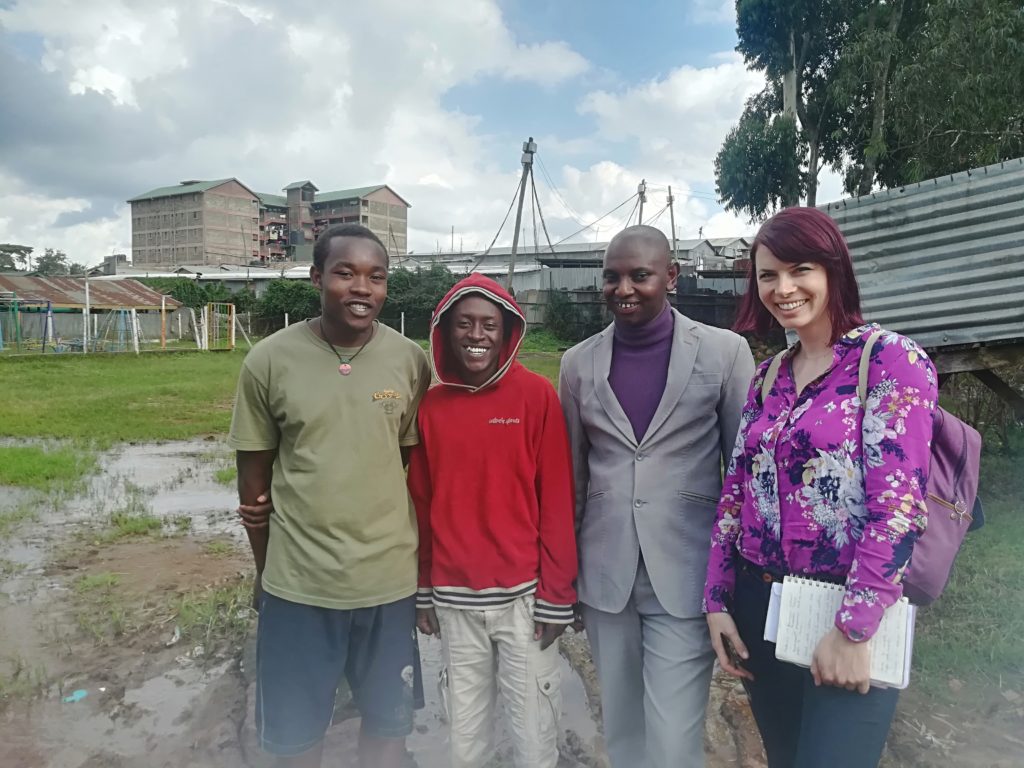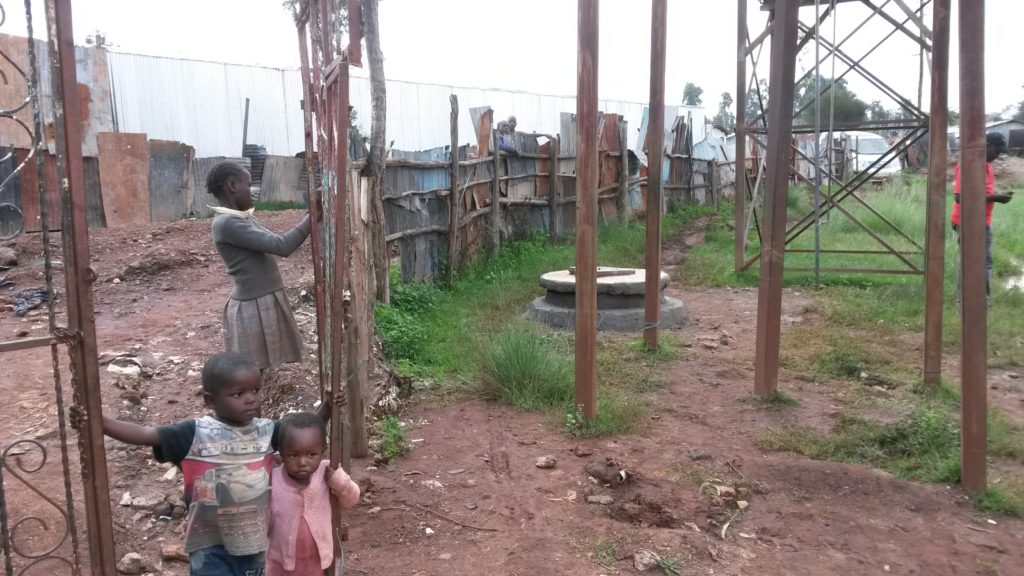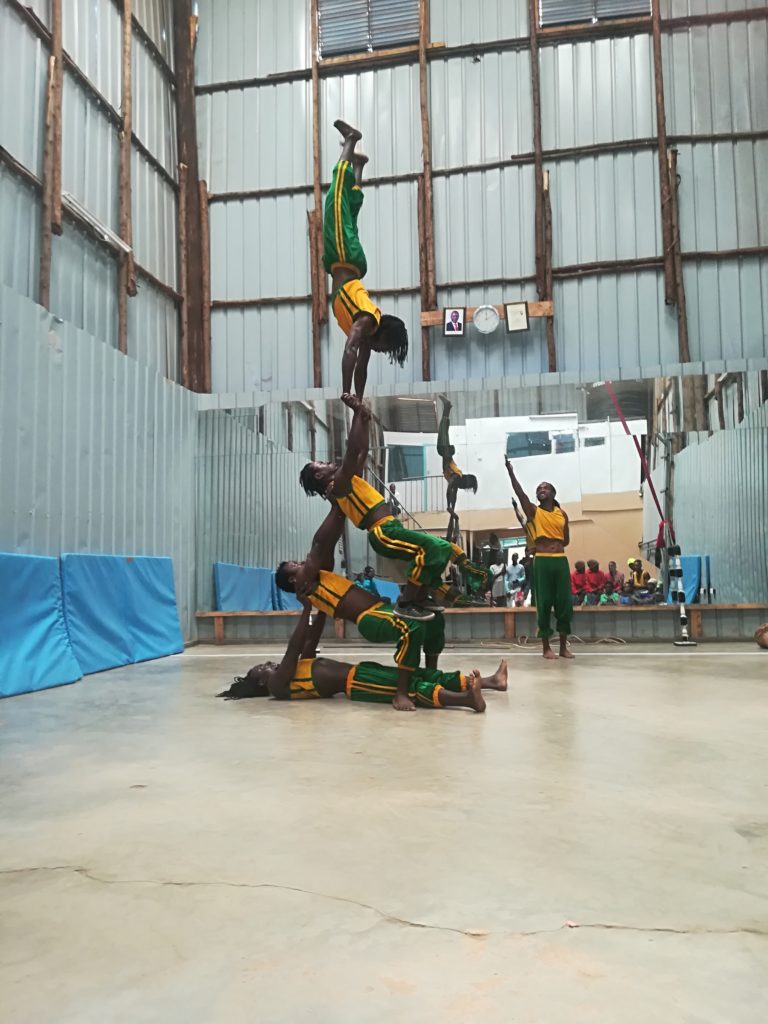Circus Against Poverty: Insight into the Social Circus Programs of Nairobi

Nairobi, Kenya. Africa. For a first-time traveler to East Africa everything is overwhelming; the sights, the sounds, the smells. The corrugated iron stalls selling multi-coloured fruits and vegetables that line the main streets, the shouts from every direction of the bus ticket sellers and the tradespeople treding their wares, the smell of mud and wet rubbish that is swept down the streets by the floods of the rainy season, washing away the roads as well as the mess of daily life on the streets of Nairobi. My senses are saturated by the information from this exciting, foreign environment full of untidy and uninhibited living.
And yet within this alien setting, I see familiar sights; stretches, squat jumps, the dreaded abs warm up… I’d arrived at the Mighty Jambo CircusAcademy.
I was lucky enough to meet John Otieno Dindy, the founder and executive director of the Mighty Jambo Trust at the Festival Mondial du Cirque de Demain at the start of this year. A former acrobat himself, John set up the circus academy with the aim of empowering youth by giving them tools to express themselves through art. The Mighty Jambo Trust now works to help artists embrace their talents and to become role models instrumental to the positive development of their communities in Nairobi and elsewhere throughout Kenya.
While Nairobi is a bustling hub of commerce and activity, more developed in many ways than one might imagine, there are still numerous problems facing many young people who live there and in other towns across Kenya. High unemployment & poverty rates mean lots of young people do not complete their schooling because they have to try to find work in order to help support their families. Their lack of education in turn limits their career prospects, thereby perpetuating the cycle of poverty and compelling some young people turn to drugs and crime as a means of supporting themselves.
The Mighty Jambo Circus Academy aims to break this cycle by teaching young people the art of circus and helping them to develop their artistic skills to a high enough level that they can perform professionally. As such, the Academy not only provides a place to go and an activity to occupy these young people, they offer them a career path and an alternative future. Their main project, a circus school is based in Gathera, Nairobi, runs programmes for children, youth and adults and also acts as a temporary home for some of its students.

Six of the 20 full time students board at the school (recently dropped to 8 due to financial restraints).The school provides them with accommodation, food, bedding, medical care, insurance, counseling, clothes, shoes and other necessities. John, the founder of the Mighty Jambo Trust, says the school offers boarding for students for many reasons; having the students living on site means they are certain to have 3 meals a day and to be kept out of the way of societal and cultural problems such as tribal violence, drug abuse, prostitution and robbery. Living on site means the trainers can also instill self-discipline and professionalism into their students without distractions from outside sources. The Mighty Jambo Trust also works with a number of different outreach projects in different neighbourhoods of Nairobi and other towns around Kenya with the aim of providing training opportunities to as many young people as possible.

During my visit I met the founders of two of these projects which run out of different parts of Nairobi. The first, the Zuma Zuma project in the Jericho region, works with junior and senior youth groups of around 20 artists. The other project I visited, the Dagoretti Artists Youth Association (DAYA), was based in the Dagoretti slum in Nairobi. This project acts as a sort of after-school club for the local children from 3 to 18 years old. Its founder Chris can have anywhere between 25 to 150 children in his classes because they are open to any child from the slum who wants to join in. He often has to rely on his older students to help with the training of the younger ones. Their top-level students then filter into the Mighty Jambo Circus Academy to complete their professional training. So far over 50 students have made this progressive step.

What is remarkable about the Mighty Jambo Circus Academy and its partner organisations is that they have to overcome so many obstacles just to be able to function. However, each and every person involved in these projects, student and teacher alike, throws themselves with such passion and dedication into their work that it doesn’t feel like they are battling against the odds to even exist. When we think about professional circus schools our minds most likely conjure up images of vast open halls strewn with high quality equipment and safety mechanisms, detailed training curriculum and the highest level of tutorage. The Mighty Jambo Circus Academy aims to produce the same quality of circus performer but instead of a state of the art training studios they have a hall built with metal sheets, wooden pillars and a concrete floor.
The school is dependent on donations from abroad for all of their specialist equipment, which is often very expensive to ship, even when there are donors willing to provide the apparatus. Some students, especially those in the outreach programs, find they cannot see their training through to completion because they need to find work to help support their families. Despite all of this though, the students I met were throwing themselves wholeheartedly into their practice, working tirelessly to achieve a career where they can travel and support themselves through their art. By the time I had arrived at the Mighty Jambo CircusAcademy at 9am, the students had already completed their 5am morning run, stretches and handstand class and were well into their warm ups for the second half of their morning classes: sprints, squat jumps, sit ups, and walking about with another person on their shoulders! Over the course of the day, the Mighty Jambo students participate in dance, music and acrobatics classes.
It is not just the students that have to overcome difficulties to take part in these circus projects; many of the trainers I met have remarkable stories about how they ended up running these social projects. The founders of the Zuma Zuma project are self-taught, having learnt the art of acrobatics through trial and error by watching others perform tricks on the beach or in the streets. They achieved such a high level of acrobatic ability that they were able to travel abroad and work for 10 years, all the while saving their earnings so that they could come back and set up an official training program for other young people in Nairobi and pass on what they had learned. Chris, the founder of the outreach program run in the Dagoretti slum in Nairobi, says he keeps part of his salary back to help the children he works with. Sometimes he has to decide between helping them and supporting his own family.

None of the organisations I visited receive any support from the government or other funding bodies. The Mighty Jambo Trust is a registered charity and the other programs are run as community programs. They exist purely thanks to the passion and hard work of their founders, stemming from their intense desire to help their communities and to better the lives of those around them.The Mighty Jambo Circus Academy aims to provide employment opportunities straight away after its students graduate. John tells us thatthe Trust’s entertainment agency, Mighty Jambo Entertainment, oversees their exit programs, creating employment opportunities locally and internationally thanks to its relationship with a network of potential employers: hotels, corporate event and entertainment agencies, circuses, theatres and theme parks.
Circus is not the cure for poverty. Learning to do a few acrobatic moves isn’t going to solve every problem facing the young people of Kenya. What circus does do though is invite everyone to join in its greatest asset; its community. Individuals hold each other up literally and metaphorically. What I witnessed in Nairobi was the building of such communities, a coming together of artists hoping to use their art to dissolve poverty from within. Somehow the dedicated leaders of the circus projects in Nairobi have built a safe haven for their students in an otherwise difficult city. These young people are taughtdiscipline through daily drills, they have role models to look up to in the students who have preceded them and in their teachers, and a vision of a better future to work towards with their newfound skills.

The goal of every student artist I met was to move to Europe and North America and to build a career there. Reaching these rich countries is the end goal and every success story I heard was about someone who had managed to move away. Where does that leave the schools and the teachers that gave these young performers their start?How sustainable is this as a system, where a few successful artists or troupes make it big abroad but the schools where they had their humble beginnings remain impoverished? The different programs I met in Nairobi have started to work together, forming the Nairobi Social Circus Network to ensure a quality standard in their training practices and to share employment opportunities. The African Circus Arts Festival, which had its first edition in 2015, is a sign of the African circus community coming together for the development of their practice and of a changing respect for the circus arts within Africa. However, it still seems that the rate of those leaving Africa to search for work abroad is greater than those choosing to stay and develop the circus market at home.
I have heard it said that social circus is just social work and team building games and cannot be considered ‘real’ circus. The lines of what defines circus are indeed stretched far when we consider the aim of social circus organisations being to create social change and not just to fulfill the original goal of traditional circus performance; delighting an audience or presenting an artistic creation.
 My reaction to that point of view is to say that if circus can bring satisfaction to people beyond the audience of a theatre or a big top then so much the better. And what is more, if using the word circus to describe the work that social circuses do helps them to reach out and make connections to the professional circus network, fantastic! The sharing of resources and knowledge between these two communities can only be mutually beneficial, producing a world that has been rendered just a tiny bit better thanks to the generous natures of circus performers and producers along with social circus volunteers and project directors.
My reaction to that point of view is to say that if circus can bring satisfaction to people beyond the audience of a theatre or a big top then so much the better. And what is more, if using the word circus to describe the work that social circuses do helps them to reach out and make connections to the professional circus network, fantastic! The sharing of resources and knowledge between these two communities can only be mutually beneficial, producing a world that has been rendered just a tiny bit better thanks to the generous natures of circus performers and producers along with social circus volunteers and project directors.
What will stay with me from my time in Nairobi with the Mighty Jambo CircusAcademy and its collaborators is witnessing the generosity of people with far less than I, or anyone I know, and seeing the wave of benefit started by this handful of passionate people who are willing to give what little they have to help those around them. Everyone I met during my day’s visit shared a common thread; the joy of creating, giving or sharing circus gave a meaning to their lives. The lesson to be taken from this? Passionate individuals working together for a common goal can change the course of other people’s lives and circus can make the world just that little bit better.
I would like to say a big thank you to Mathias Nyamai, John Otieno Dindy, Sarah Allen and all the students and trainers from the Mighty Jambo Trust for making this visit possible. For more information about the Mighty Jambo Trust, find them on Circus Talk and Facebook. I am currently raising money to send a unicycle, that has been donated by another circus company, to the Mighty Jambo Circus Academy. The link can be found on my profile.
All photos courtesy of Kirsty Bell
Editor's Note: At StageLync, an international platform for the performing arts, we celebrate the diversity of our writers' backgrounds. We recognize and support their choice to use either American or British English in their articles, respecting their individual preferences and origins. This policy allows us to embrace a wide range of linguistic expressions, enriching our content and reflecting the global nature of our community.
🎧 Join us on the StageLync Podcast for inspiring stories from the world of performing arts! Tune in to hear from the creative minds who bring magic to life, both onstage and behind the scenes. 🎙️ 👉 Listen now!
